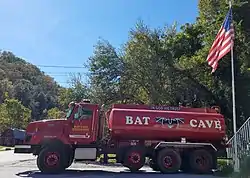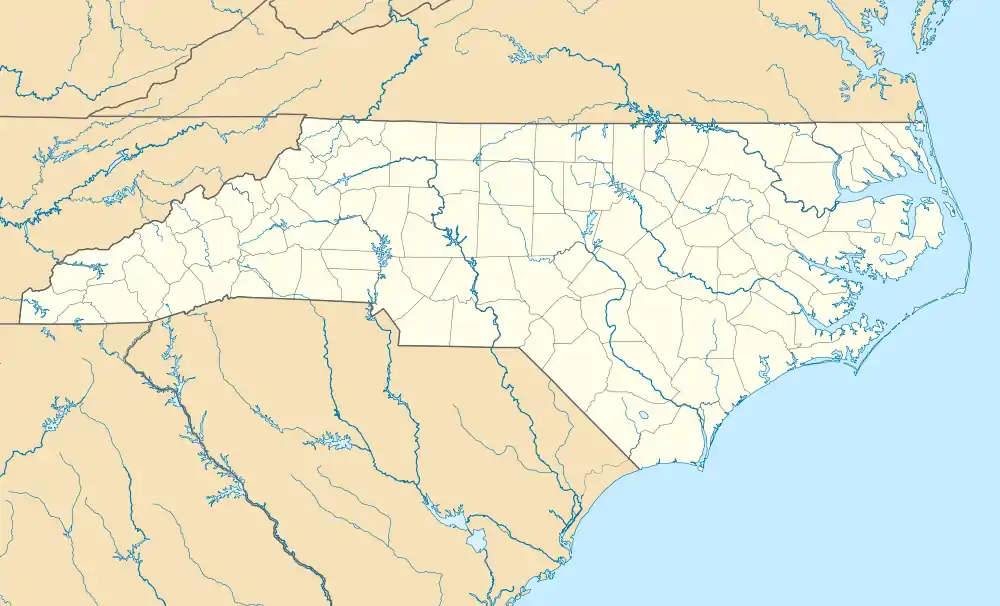Bat Cave, North Carolina
Bat Cave is an unincorporated community in Henderson County, North Carolina and is part of the Asheville Metropolitan Statistical Area. Named after a bat cave located on Bluerock Mountain (also known as Bat Cave Mountain), it is largest known augen gneiss granite fissure cave in North America and is a protected area, not open to the public.[4] It has frequently been noted on lists of unusual place names.[5][6]
Bat Cave, North Carolina | |
|---|---|
 Bat Cave Fire Engine (tanker truck). | |
 Bat Cave  Bat Cave | |
| Coordinates: 35°27′05″N 82°17′13″W | |
| Country | United States |
| State | North Carolina |
| County | Henderson |
| Named for | A bat cave, located on Bluerock Mountain[1] |
| Elevation | 1,480 ft (451 m) |
| Time zone | UTC-5 (Eastern (EST)) |
| • Summer (DST) | UTC-4 (EDT) |
| ZIP code | 28710[2] |
| Area code(s) | 828 |
| GNIS feature ID | 1018981[3] |
The community, located along the banks of the Broad River and within the Hickory Nut Gorge, features several shops, inns and a post office. It is also where three highways merge, U.S. Route 64 (US 64) from Hendersonville, U.S. Route 74A (US 74A) from Asheville, and North Carolina Highway 9 (NC 9) from Black Mountain, becoming Lake Lure Highway; which then continues in a southeasterly direction to Chimney Rock and Lake Lure.
History
The area was first connected by a Drovers' road, a natural access into the interior of the Blue Ridge Mountains for drovers who were moving livestock, mostly flocks of turkeys and some geese, herds of hogs and some cattle in and out of the mountains to the markets. Established in 1798, it connected the area with Asheville, following on what is today US 74A.[7] In 1879, the Bat Cave Post Office opened; previously known as Chimney Rock Post Office, it originally opened in 1843 (located where what is now Lake Lure) and had a series of closures before its relocation and renaming. The post office was destroyed, as was much of the community, during the flood of 1916, but was later rebuilt. In the 1920s, the Bat Cave community, and its famous cave, became a popular tourist attraction. The 186-acre (75 ha) Bat Cave Preserve was setup in response to that popularity and help protect the endangered Indiana bats as well as several other species of bats that inhabit the cave.[8][9]
In 1948, Navy Captain George Bond established the Valley Clinic and Hospital, who was recognized as "Doctor of the Year" in 1953. In the 1970s, the Bat Cave Volunteer Fire Department was organized.[8]
Notable people
References
- "North Carolina Gazetteer". Retrieved December 26, 2020.
- Zip Code Lookup Archived May 17, 2011, at the Wayback Machine
- "Bat Cave, North Carolina". Geographic Names Information System. United States Geological Survey. Retrieved April 30, 2012.
- "The Mystique of North Carolina's Bat Cave". Hendersonville Best. Retrieved December 26, 2020.
- Kramp, Penn (Feb 22, 1987). "Tuxedo: It's not formal wear". The Times-News. p. 27. Retrieved May 23, 2015.
- Parker, Quentin (2010). Welcome to Horneytown, North Carolina, Population: 15: An insider's guide to 201 of the world's weirdest and wildest places. Adams Media. pp. viii. ISBN 9781440507397.
- "Drover's Road By-Way Scenic Drive in Rutherford County, North Carolina". The Blue Ridge Highlander. Retrieved December 26, 2020.
- "Bat Cave and Middle Fork". Henderson Heritage. Retrieved December 26, 2020.
- "Bat Cave Preserve, North Carolina Nature Conservancy". Carolina Outdoors Guide. Retrieved December 26, 2020.
External links
 Media related to Bat Cave, North Carolina at Wikimedia Commons
Media related to Bat Cave, North Carolina at Wikimedia Commons- Henderson County Visitors Information Center
